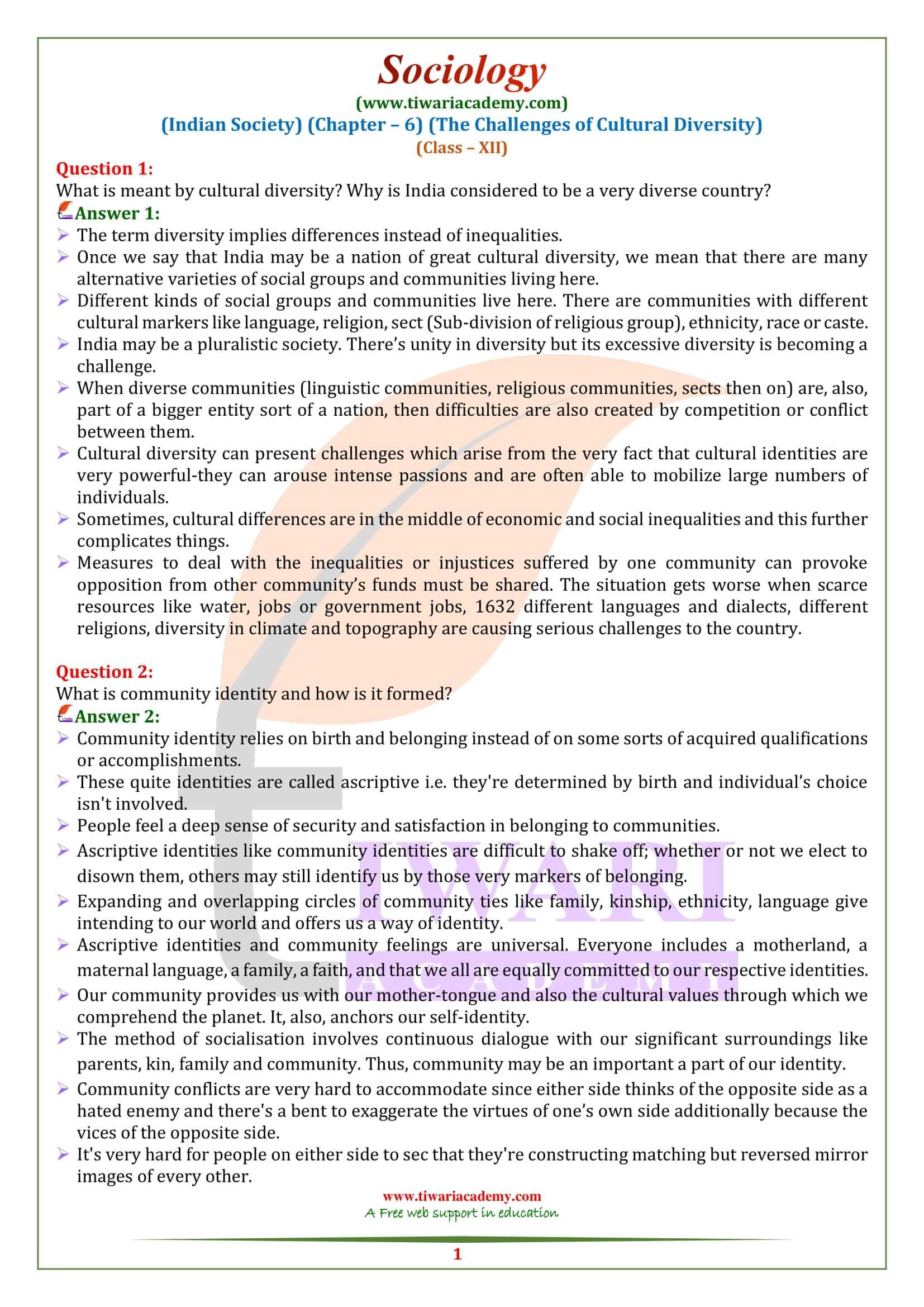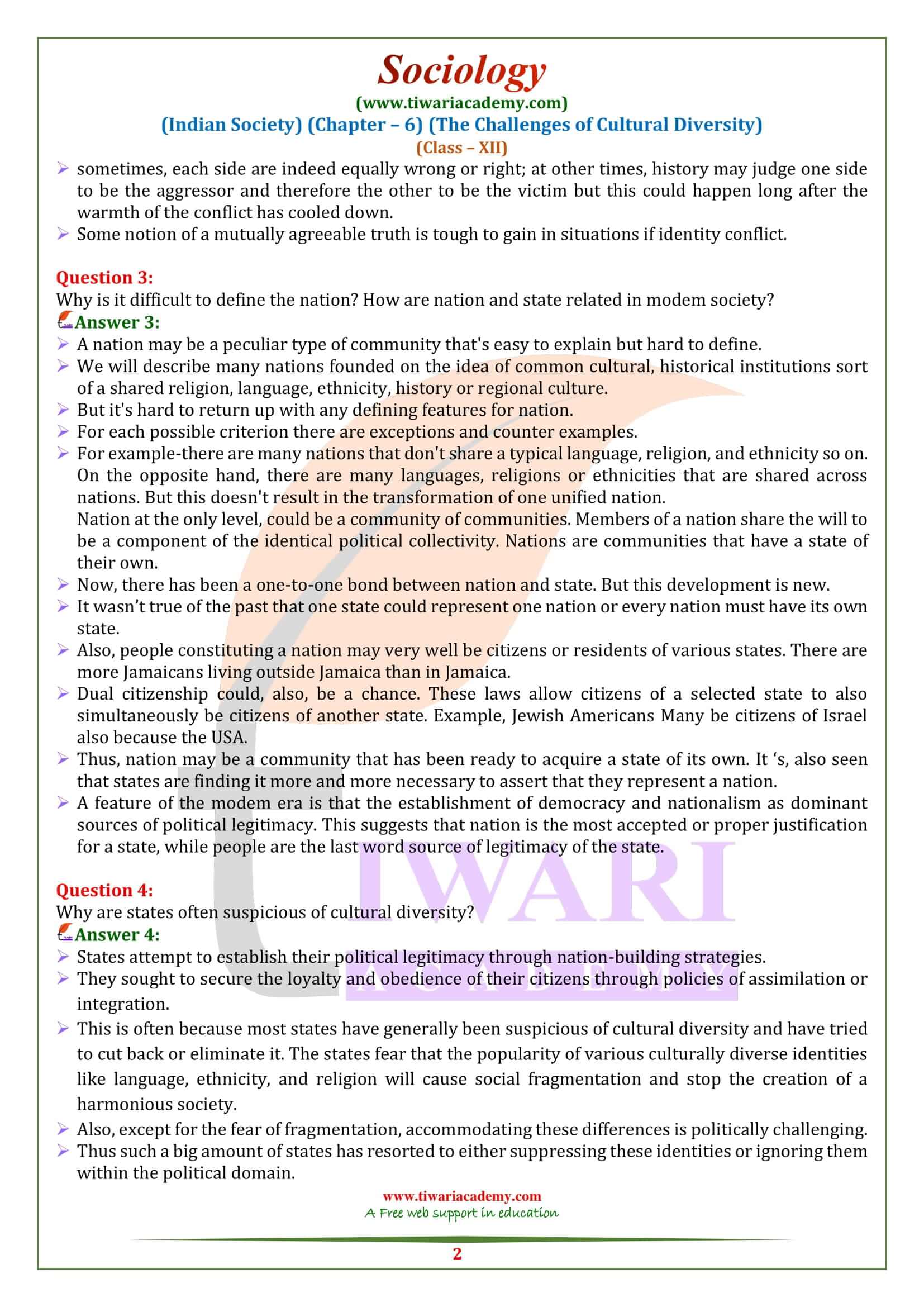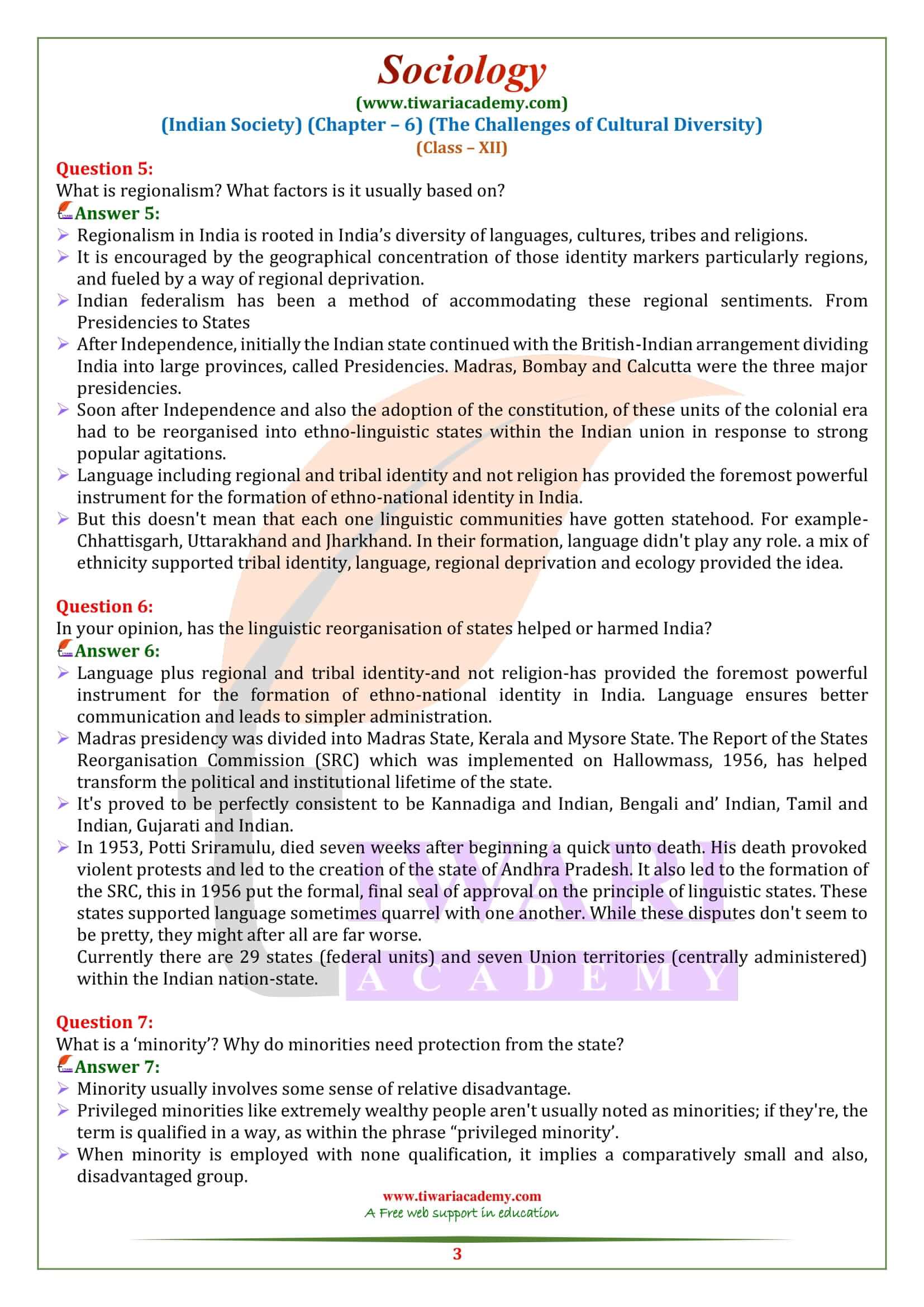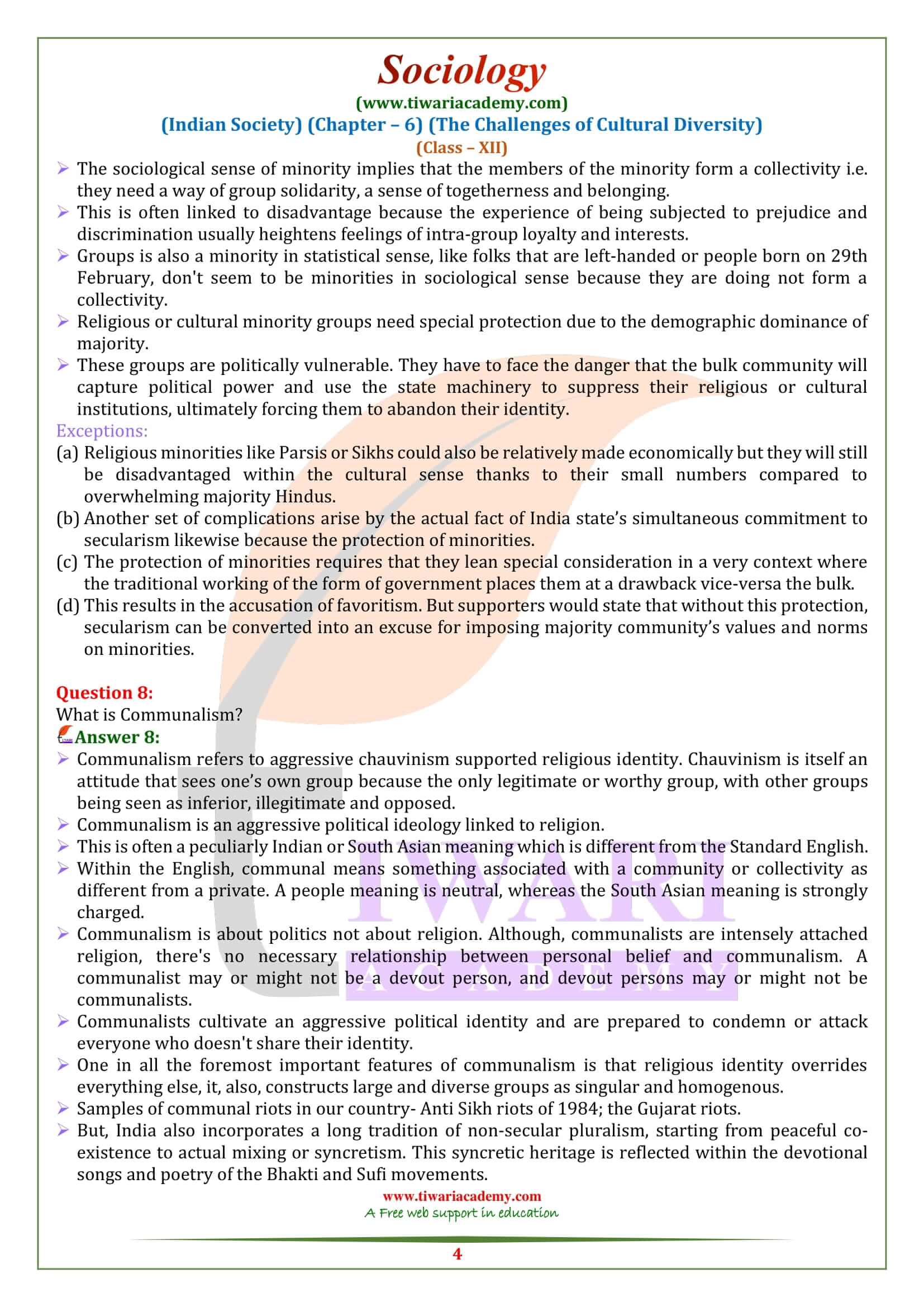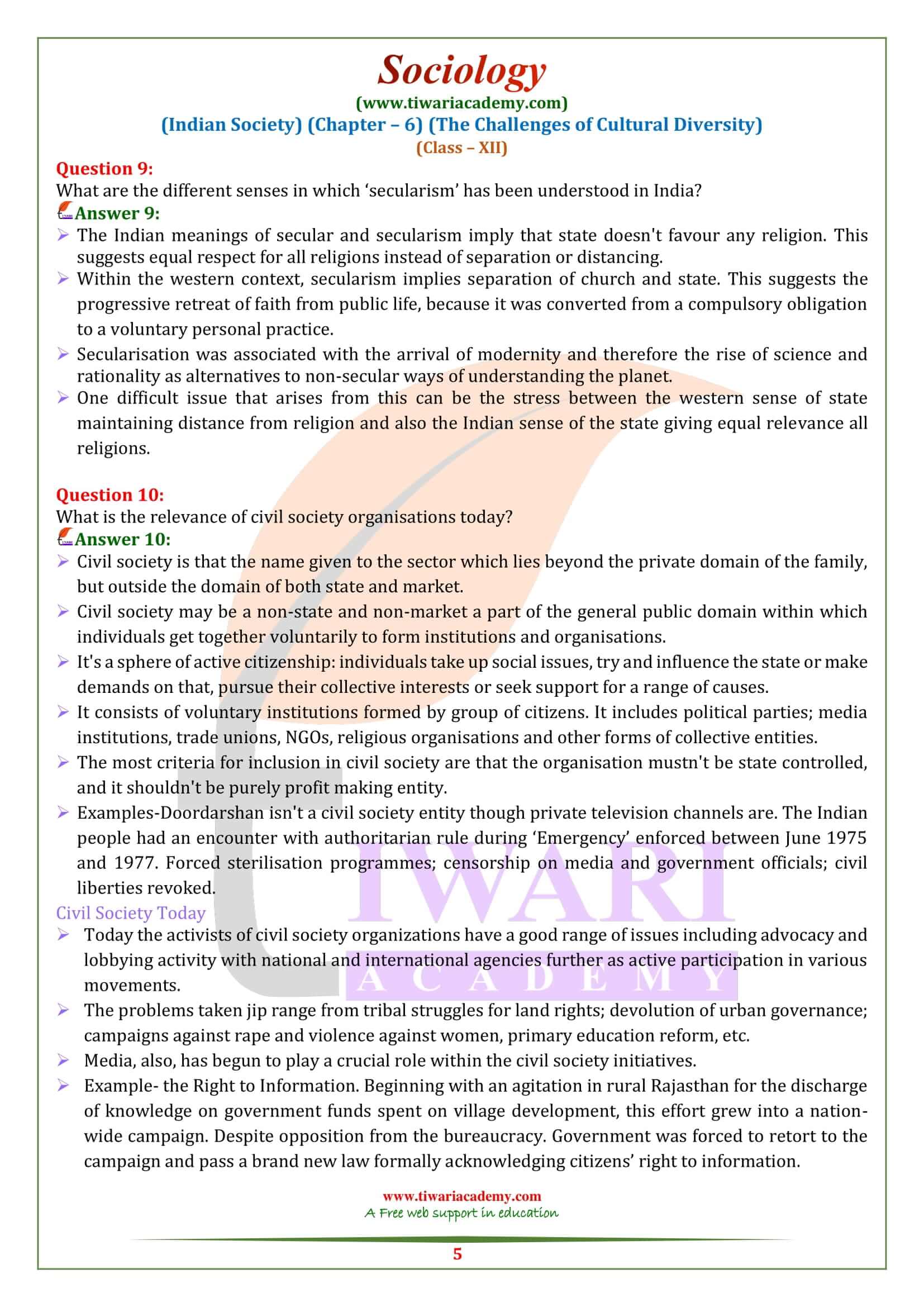NCERT Solutions for Class 12 Sociology Chapter 6 the Challenges of Cultural Diversity prepared and updated for new academic session 2025-26. Class 12 Sociology Part 1 Indian Society chapter 6 question answers, MCQ and important extra question are useful for CBSE as well as State board students.
Class 12 Sociology Chapter 6 the Challenges of Cultural Diversity Question Answers
What is meant by cultural diversity? Why is India considered to be a very diverse country?
The term diversity implies differences instead of inequalities.
Once we say that India may be a nation of great cultural diversity, we mean that there are many alternative varieties of social groups and communities living here.
Different kinds of social groups and communities live here. There are communities with different cultural markers like language, religion, sect (Sub-division of religious group), ethnicity, race or caste.
India may be a pluralistic society. There’s unity in diversity but its excessive diversity is becoming a challenge.
When diverse communities (linguistic communities, religious communities, sects then on) are, also, part of a bigger entity sort of a nation, then difficulties are also created by competition or conflict between them.
Cultural diversity can present challenges which arise from the very fact that cultural identities are very powerful-they can arouse intense passions and are often able to mobilize large numbers of individuals.
Sometimes, cultural differences are in the middle of economic and social inequalities and this further complicates things.
Measures to deal with the inequalities or injustices suffered by one community can provoke opposition from other community’s funds must be shared. The situation gets worse when scarce resources like water, jobs or government jobs, 1632 different languages and dialects, different religions, diversity in climate and topography are causing serious challenges to the country.
What is community identity and how is it formed?
Community identity relies on birth and belonging instead of on some sorts of acquired qualifications or accomplishments.
These quite identities are called ascriptive i.e. they’re determined by birth and individual’s choice isn’t involved.
People feel a deep sense of security and satisfaction in belonging to communities.
Ascriptive identities like community identities are difficult to shake off; whether or not we elect to disown them, others may still identify us by those very markers of belonging.
Expanding and overlapping circles of community ties like family, kinship, ethnicity, language give intending to our world and offers us a way of identity.
Ascriptive identities and community feelings are universal. Everyone includes a motherland, a maternal language, a family, a faith, and that we all are equally committed to our respective identities.
Our community provides us with our mother-tongue and also the cultural values through which we comprehend the planet. It, also, anchors our self-identity.
The method of socialisation involves continuous dialogue with our significant surroundings like parents, kin, family and community. Thus, community may be an important a part of our identity.
Community conflicts are very hard to accommodate since either side thinks of the opposite side as a hated enemy and there’s a bent to exaggerate the virtues of one’s own side additionally because the vices of the opposite side.
It’s very hard for people on either side to sec that they’re constructing matching but reversed mirror images of every other.
sometimes, each side are indeed equally wrong or right; at other times, history may judge one side to be the aggressor and therefore the other to be the victim but this could happen long after the warmth of the conflict has cooled down.
Some notion of a mutually agreeable truth is tough to gain in situations if identity conflict.
Why are states often suspicious of cultural diversity?
States attempt to establish their political legitimacy through nation-building strategies. They sought to secure the loyalty and obedience of their citizens through policies of assimilation or integration.
This is often because most states have generally been suspicious of cultural diversity and have tried to cut back or eliminate it. The states fear that the popularity of various culturally diverse identities like language, ethnicity, and religion will cause social fragmentation and stop the creation of a harmonious society.
Also, except for the fear of fragmentation, accommodating these differences is politically challenging.
Thus such a big amount of states has resorted to either suppressing these identities or ignoring them within the political domain.
What is regionalism? What factors is it usually based on?
- Regionalism in India is rooted in India’s diversity of languages, cultures, tribes and religions.
- It is encouraged by the geographical concentration of those identity markers particularly regions, and fueled by a way of regional deprivation.
- Indian federalism has been a method of accommodating these regional sentiments. From Presidencies to States
- After Independence, initially the Indian state continued with the British-Indian arrangement dividing India into large provinces, called Presidencies. Madras, Bombay and Calcutta were the three major presidencies.
- Soon after Independence and also the adoption of the constitution, of these units of the colonial era had to be reorganised into ethno-linguistic states within the Indian union in response to strong popular agitations.
- Language including regional and tribal identity and not religion has provided the foremost powerful instrument for the formation of ethno-national identity in India.
- But this doesn’t mean that each one linguistic communities have gotten statehood. For example- Chhattisgarh, Uttarakhand and Jharkhand. In their formation, language didn’t play any role. a mix of ethnicity supported tribal identity, language, regional deprivation and ecology provided the idea.
In your opinion, has the linguistic reorganisation of states helped or harmed India?
Language plus regional and tribal identity-and not religion-has provided the foremost powerful instrument for the formation of ethno-national identity in India. Language ensures better communication and leads to simpler administration.
Madras presidency was divided into Madras State, Kerala and Mysore State. The Report of the States Reorganisation Commission (SRC) which was implemented on Hallowmass, 1956, has helped transform the political and institutional lifetime of the state.
It’s proved to be perfectly consistent to be Kannadiga and Indian, Bengali and Indian, Tamil and Indian, Gujarati and Indian.
In 1953, Potti Sriramulu, died seven weeks after beginning a quick unto death. His death provoked violent protests and led to the creation of the state of Andhra Pradesh. It also led to the formation of the SRC, this in 1956 put the formal, final seal of approval on the principle of linguistic states. These states supported language sometimes quarrel with one another. While these disputes don’t seem to be pretty, they might after all are far worse. Currently there are 29 states (federal units) and seven Union territories (centrally administered) within the Indian nation-state.
What is the unique feature of the chapter 6 in class 12 Sociology?
Class 12 sociology chapter 6 is one of the important chapters. It has been allotted 8 marks in CBSE against 6 marks each for all other opponents.
What are the main terms to focus to revise chapter 6 of class 12 sociology?
As we know that chapter 6 of class 12 sociology is important from examination point of view. So, students must focus on the topics like Colonialism, Communalism, community, Democracy, Nation, Nationalism, Pluralism and Secularism.
What are the most important questions from chapter 6 of class 12 sociology?
The most important questions from chapter 6 are as follows:
- What is meant by cultural diversity? Why is India considered to be a very diverse country?
- In your opinion, has the linguistic reorganization of states helped or harmed India?
- What is a ‘minority’? Why do minorities need protection from the state?
